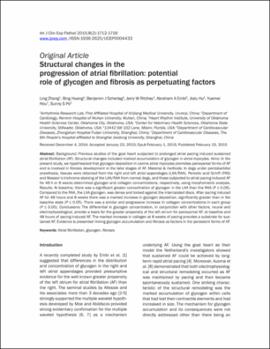| dc.contributor.author | Zhang, Ling | |
| dc.contributor.author | Huang, Bing | |
| dc.contributor.author | Scherlag, Benjamin J. | |
| dc.contributor.author | Ritchey, Jerry W. | |
| dc.contributor.author | Embi, Abraham A. | |
| dc.contributor.author | Hu, Jialu | |
| dc.contributor.author | Hou, Yuemei | |
| dc.contributor.author | Po, Sunny S. | |
| dc.date.accessioned | 2019-09-25T18:24:46Z | |
| dc.date.available | 2019-09-25T18:24:46Z | |
| dc.date.issued | 2015-02-15 | |
| dc.identifier | oksd_zhang_structuralchang_2015 | |
| dc.identifier.citation | Zhang, L., Huang, B., Scherlag, B. J., Ritchey, J. W., Embi, A. A., Hu, J., ... Po, S. S. (2015). Structural changes in the progression of atrial fibrillation: Potential role of glycogen and fibrosis as perpetuating factors. International Journal of Clinical and Experimental Pathology, 8(2), 1712-1718. | |
| dc.identifier.uri | https://hdl.handle.net/11244/321449 | |
| dc.description.abstract | Background: Previous studies of the goat heart subjected to prolonged atrial pacing induced sustained atrial fibrillation (AF). Structural changes included marked accumulation of glycogen in atrial myocytes. Aims: In the present study, we hypothesized that glycogen deposition in canine atrial myocytes promotes paroxysmal forms of AF and is involved in fibrosis development in the later stages of AF. Material & methods: In dogs under pentobarbital anesthesia, tissues were obtained from the right and left atrial appendages (LAA/RAA). Periodic acid Schiff (PAS) and Masson's trichrome staining of the LAA/RAA from normal dogs, and those subjected to atrial pacing induced AF for 48 h or 8 weeks determined glycogen and collagen concentrations, respectively, using morphometric analysis. Results: At baseline, there was a significant greater concentration of glycogen in the LAA than the RAA (P </= 0.05). Compared to the RAA, the LAA glycogen, was dense and locked against the intercalated discs. After pacing induced AF for 48 hours and 8 weeks there was a marked increase in glycogen deposition, significantly greater than in the baseline state (P </= 0.05). There was a similar and progressive increase in collagen concentrations in each group (P </= 0.05). Conclusions: The differential in glycogen concentration, in conjunction with other factors, neural and electrophysiological, provide a basis for the greater propensity of the left atrium for paroxysmal AF, at baseline and 48 hours of pacing induced AF. The marked increase in collagen at 8 weeks of pacing provides a substrate for sustained AF. Evidence is presented linking glycogen accumulation and fibrosis as factors in the persistent forms of AF. | |
| dc.format | application/pdf | |
| dc.language | en_US | |
| dc.publisher | e-Century Publishing | |
| dc.rights | This material has been previously published. In the Oklahoma State University Library's institutional repository this version is made available through the open access principles and the terms of agreement/consent between the author(s) and the publisher. The permission policy on the use, reproduction or distribution of the material falls under fair use for educational, scholarship, and research purposes. Contact Digital Resources and Discovery Services at lib-dls@okstate.edu or 405-744-9161 for further information. | |
| dc.title | Structural changes in the progression of atrial fibrillation: Potential role of glycogen and fibrosis as perpetuating factors | |
| osu.filename | oksd_zhang_structuralchang_2015.pdf | |
| dc.description.peerreview | Peer reviewed | |
| dc.description.department | Veterinary Pathobiology | |
| dc.type.genre | Article | |
| dc.type.material | Text | |
| dc.subject.keywords | atrial fibrillation | |
| dc.subject.keywords | fibrosis | |
| dc.subject.keywords | glycogen | |
